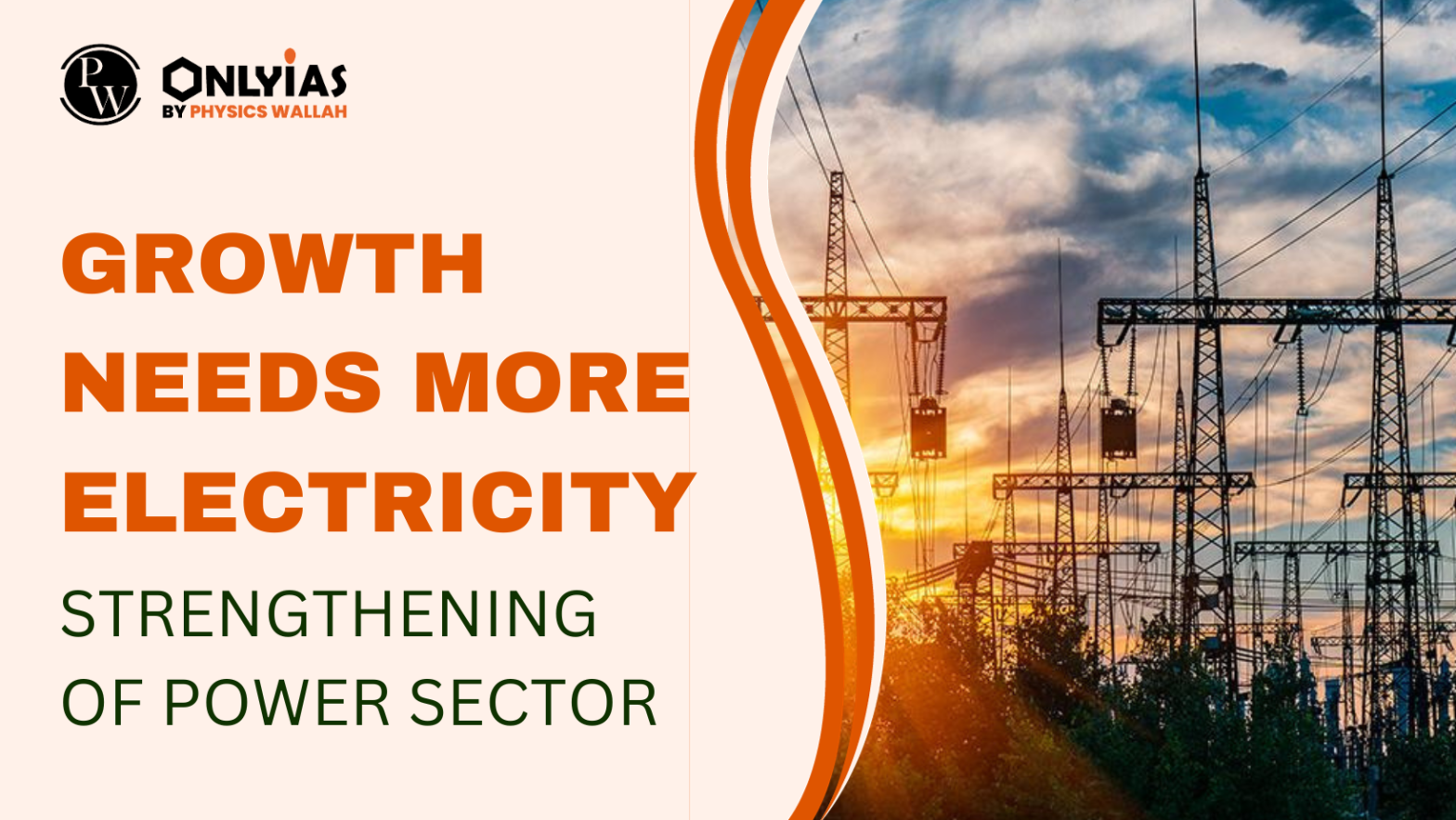Context: This article is based on an Editorial “Growth Needs More Electricity” which was published in Business standard. The Central Electricity Authority (CEA) projects India’s power sector demand to increase 1.8 times between 2021-22 and 2031-32. At this rate, India’s annual per capita electricity consumption will be about 1,700-1,800 units in 2031-32.
| Relevancy for Prelims: The Central Electricity Authority (CEA), India’s targets of Renewable Energy, Various Government initiatives to reform the power sector.
Relevancy for Mains: Indian Economy, Infrastructure and Government Policies & Interventions. |
Power Sector at a Glance:
- Installed Generation Capacity (Fuelwise): Fossil Fuel – 2,37,269MW (56.8%) in which Coal and Lignite has largest share 50.7%,
- India stands 4th globally in Renewable Energy Installed Capacity, with 43% of its total installed electricity capacity (175GW) coming from non-fossil energy sources (Solar 16.1% and Wind-10.3%).
Navigating Challenges in India’s Power Sector Transformation:
- Policy and Regulation of power Sector: Electricity is listed in a ‘concurrent list’ in seven schedules, therefore there is lack of coordination and cooperation between center and states.
- Government subsidy and cross-subsidy from industrial and commercial consumers attempt to keep electricity affordable for residential and agricultural consumers.
- For example, in 2019-20, while 21% of the total electricity supply was sold to agricultural consumers, their share in the total revenue was only 2%.
- Generation of electricity in the power sector: In spite of the renewables push, coal still accounts for about 50% of India’s installed power capacity.
- CEA identified land acquisition, fund constraints with contractors, and contractual disputes as some key issues leading to delays.
- Transmission issue in power sector: The country’s weak transmission grid remains a serious hurdle.
- For example: A planned approach to build huge solar plants in Leh was recently canceled due to a lack of transmission infrastructure.
- Transmission lines overloading: Due to higher loads during peak hours, transmission lines frequently experience issues.
- Distribution in power sector: Discoms are the weakest link in India’s Power sector.
- Discoms continue to register financial losses, technical and commercial losses remain high.
- Although private participation is permitted, their presence among discoms is limited.
- Climate Finance and decarbonization: India’s pledge at the COP-26 summit to have 500 GW of non-fossil generation capacity by 2030. These will require investments of about Rs 32 lakh crore.
- Underutilization of Renewable Energy Potential: The National Electricity Plan (NEP) projects a compounded annual growth rate (CAGR) of 7% in energy demand from FY22 to FY27.
- The report estimates that the pace of solar installations will need to double to over 30 GW per year to meet the NEP targets.
Government Initiatives to Reform the Power Sector:
- The Pradhan Mantri Sahaj Bijli Har Ghar Yojana (SAUBHAGYA): It aims to achieve universal household electrification by providing electricity connections to all un-electrified households.
- Deen Dayal Upadhyaya Gram Jyoti Yojana (DDUGJY): The DDUGJY launched in 2014 a program to achieve 100% village electrification.
- The Unnat Jyoti by Affordable LEDs for All (UJALA) scheme: To provide energy efficient LED bulbs to domestic consumers at an affordable price.
- Restructured Distribution Sector Scheme (RDSS): To enhance the efficiency of power distribution.
- UDAY Scheme: Launched in 2015 for Operational and Financial Turnaround of Power Distribution Companies.
|
Way Forward: Policy Reforms for a Transformed Power Sector:
- Regulation and Policy:
- The state governments should promote autonomy, competence, and transparency of the State Electricity Regulatory Commission (SERC).
- Subsidy Structure: The status quo with subsidies that are financed using deficits and debt need reforms.
- Decentralized Power Generation: It means energy is now created, stored, and delivered.
- Separation of Feeders i.e., agricultural use from non-agricultural use should be done.
- Reforms In Coal Sector: Increase Production and competition leveraging producing mines to enable more world-scale operation.
- Privatization of Discoms: Make a suitable case for privatization to enhance efficiency and reduce financial losses.
- Technology Upgradation: Intelligent metering and a digital network infrastructure allow consumers and utility companies to monitor and better control allowing for more efficient consumption and cost management.
Conclusion:
- India’s growing economy demands an exponential increase in electricity supply. To meet this challenge, comprehensive reforms in policy, regulation, and the entire power sector are essential. By embracing decentralization, upgrading technology, and privatizing distribution companies, India can pave the way for a more efficient and sustainable power sector, ensuring a brighter future for its citizens.
![]() 20 Sep 2023
20 Sep 2023

